You are currently browsing the batman category
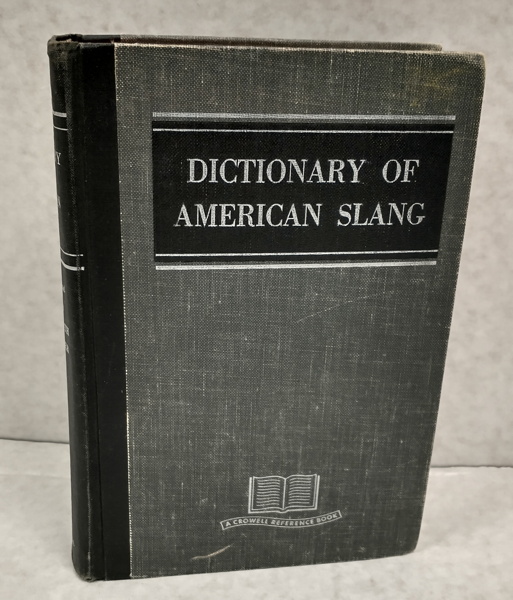
So a few decades back, my maternal grandmother (whom we called “Nana,” as “Grandma” “sounded old”) gave me the above book, found in one of her visits to a second-hand store. It is, as it says, the Dictionary of American Slang, and it is a first edition from 1960. It was, and still is, the source of much education and enjoyment, beyond immediately looking up all the dirty words I could find, of course, but even doing that was turned out to be more informative than prurient. It was a great gift, and one I still treasure to this day, though I know it has since been revised and updated, and there are any number of competing volumes on the same topic.
So why do I bring this up here, other than to show off something neat from ye olde Mikester bookshelves? Well, it came to mind while listening to pals Matt ‘n’ Chris on the latest “Every Story Ever” special from their War Rocket Ajax comics podcast. In said special, where they rank comic stories submitted by listeners, with Identity Crisis at the bottom and a comic that isn’t an issue of Swamp Thing at the top, a listener sent in Batman #66 (1951) for their consideration.
Oh, which comic is Batman #66 (1951), you’re asking? “Why, we’re not familiar with that particular issue!” you add. To which I respond, “oh, you know this comic.” In fact, there was a time on the internets where you couldn’t avoid the continuing mirth this comic inspired, with its panels scanned and uploaded and shared and hotlinked to the point of everyone everywhere getting an eyeful of Joker’s boner:
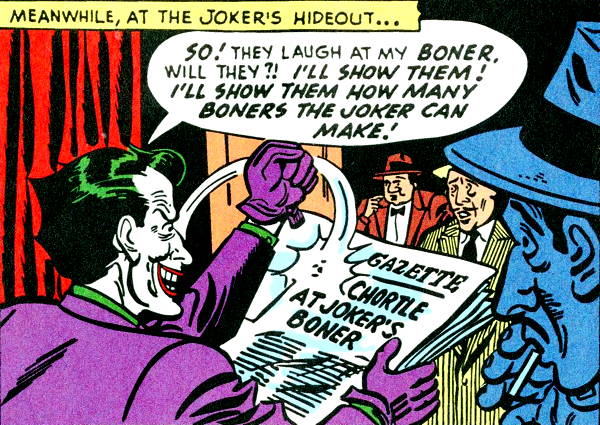
Yup, it’s that story, officially titled “The Joker’s Comedy of Errors!” and, according to the Grand Comics Database, credited to writer Bill Finger and artists Lew Sayre Schwartz, Charles Paris, and, surprisingly, Bob Kane, who apparently did draw the figures of Batman and Robin themselves, probably under duress.
Anyway, you’ve seen the panels, there are lots of talk about “boners” (in the meaning of “mistakes”) and reading those panels in our hip, modern, ironic age, where “boner” can mean something else entirely…well, you can see how the story comes across quite a bit differently now. The entire story is “boner” this and “boner that” – “how can he force you into a boner?” “They laugh at my boner, will they?” “More boner crimes to come!” And so on.
Now, the Bits Boys on War Rocket Ajax contend, as many do, that at the time of the comic’s publication in the early 1950s, “boner” did not have the more vulgar meaning associated with it today. In contrast, I posted on the Twitters that the writer of the book knew exactly what he was doing, entertaining himself with a story-long dirty joke that he got past his editor.
Which got me to thinking. I once heard that pretty much any filthy word you know now, people knew back then, and whatever scatological or sexual term you may utter ain’t any different from what your great-grandpa would say. You don’t need to tell me that’s overstating it a bit, as I’m aware. But it would seem that “boner” in its vulgar sense wouldn’t necessarily be a recent innovation, would it?
Thus, to the slang dictionary, where the definition of “boner,” as it stands (heh) in 1960, according to this book’s editors:
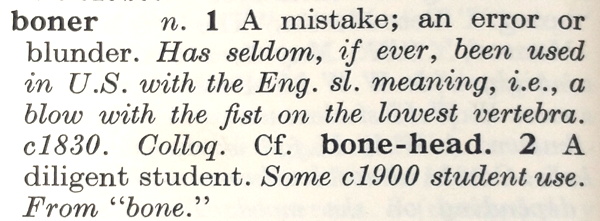
That’s that then, I guess, right? Well, not necessarily, in that 1) this is the first edition of this work, and perhaps future revisions have expanded the entry and provided more dating citations, and 2) I’m sure some slang didn’t make it in, either from limited use or just not being picked up during the research phase.
And then there’s this…the definition for “bone” just a couple of entries earlier. Didn’t take a pic, as it’s a long (heh) entry, but definition #5 is “[taboo] The penis, esp. the erect penis.” So at least by 1960 the base (heh – okay, I’ll stop) of “boner” is present and notable. It feels like it isn’t that far of a jump from “bone” to “boner,” particularly since the term “boner” already exists in a more socially acceptable form and thus was a recognizable variant of the word.
I did some further online research, which of course required typing the word “boner” into website after website — hello, NSA! — and didn’t find very many helpful citations. One that did seem to support the idea that ol’ Bill Finger was pulling a fast one in his funnybookin’ was this entry from Entomology Online, which notes
“Meaning ‘erect penis’ is 1950s, from earlier bone-on (1940s), probably a variation (with connecting notion of ‘hardness’) of hard-on (1893).”
I checked for “bone-on” in my Dictionary of American Slang and found nothing, which again could just mean it was missed in the initial surveys.
This other online source, Green’s Dictionary of Slang, has as its earliest citation for the meaning we’re seeking as 1966. And Merriam-Webster cites a date of 1896 as the earliest use of the word “boner,” admittedly not in its naughty sense. But the construction “boner” existed in the world, and again, I contend it’s not that big a leap from “bone” meaning an erect penis to “boner” meaning the same thing.
Whether it was in common usage by the early 1950s is another question. I think it’s possible Bill Finger would have known the other meaning of the term…we would have only been about 37 at the time, still young enough to have been at least vaguely aware of the New Hip Slang all the kids were using, but, to be honest, probably old enough not to want to screw up a paying gig by trying to get a dirty joke into print in a children’s comic book.
As such, my assumption is…while “boner” (or at least close variations of it) may have been in use with its sexual definition at the time, Finger most likely used it innocently in this story. Howver, I’m guessing a non-zero percentage of readers in 1951 probably found this as funny as a bunch of bloggers did circa 2006, for the exact same reason.
Now this whole Toni Gay/Butch Dykeman thing that pal Andrew reminded me about:
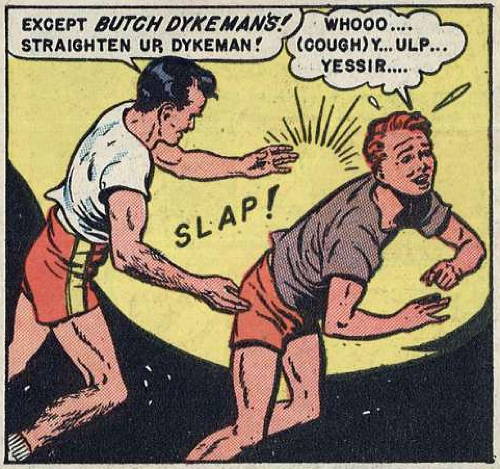
…I mean, there’s no reason to expect that was anything but innocent comic booking, surely.
Note: I know about the Nicholas Cage dirty word documentary series on Netflix.
Also, if you have additional information/links regarding the history of “boner” — yes, please leave that in the comments. We’ll get a grip on these boners yet!
So in Justice League #42 (cover date September 2015, released July 2015), the following happens. Batman, gets a hold of Metron’s Mobius Chair, a repository of nearly every bit of information from across the universe that it was possible to obtain, gathered by the chair’s (former) owner.
Once he plants his Bat-butt into the seat, Batman decides to test the chair’s accuracy by asking it a question:

The chair makes some pinging sounds (pinging panels omitted from this brief recap) and delivers the answer:

As you see there, Batman acknowledges that the answer was correct, pauses for a moment as he ponders his next move, then asks for the Joker’s “true name.”
The chair beeps and boops further, before delivering a tantalizingly unseen answer to Batman, who responds thusly:

And how do you keep a sucker in suspense? We’ll tell you what Batman heard several months later in Justice League #50, cover date July 2016, released May 2016:
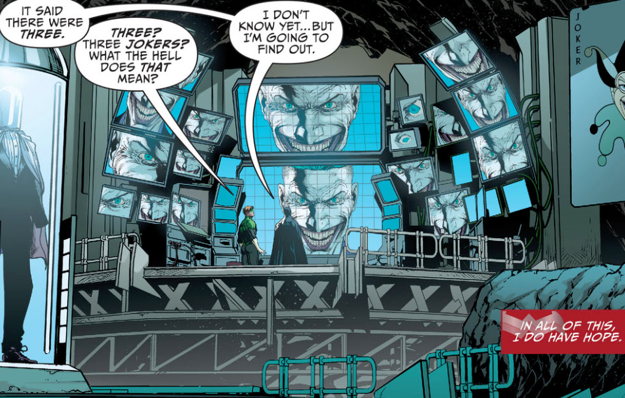
Now, cut to Fall 2020, where this Three Jokers business is finally being addressed in a prestige mini-series titled, what else, Batman: Three Jokers. I’ve gone on about the first two installments in the series, at length on the first issue here and I managed to restrain myself a bit for #2 here. The conclusion to the series is out now, and like I said in the title way up above there, there’s gonna be SPOILERS, so don’t come crying to me.
At first glance, the conclusion of Three Jokers appears inconsistent with the set-up in Justice League #42 shown above. Batman asks the Mobius Chair for the Joker’s real name. One of the big reveals in Three Jokers #3 is that Batman’s known the Joker’s real name all this time. If he knew, why’d he ask?
Well, looking back at the Justice League comics, I suppose there’s kind of an out. Batman tested the chair with a question he already knew the answer to (that Joe Chill was the murderer of his parents). Maaaaaybe, if you squint a little, one could claim that his next question about the Joker’s real name was also a test, to see if the chair would spit out the right name. The twist in that story is, of course, as we eventually find out, the whole triad of the Clown Prince of Crime thing.
The problem with that interpretation is that the comics do not read that way. In context it feels that Batman’s question about the Joker’s real name was made as a sincere inquiry, not a further test of the system. It’s…that pause before he asks, and the intensity with which he asks it. It doesn’t feel like a question being asked by a man who already knows the answer. It reads like someone excited by the chance at gaining knowledge he’s desperately sought and now finally has a chance to have.
That said, there is enough ambiguity to where both the Justice League stories and Three Jokers can remain consistent. When Green Lantern is prodding Batman in JL #50, trying to find out what the chair said, Batman evades the issue at first. He’s being deliberately cagey in relation to any questions about the Joker’s true identity, perhaps because of what we know now from the ending of #3. He doesn’t want to discuss the subject in order to protect….
…Well, yes, protect whom? So way back when, Alan Moore and Brian Bolland’s Batman: The Killing Joke gives us a backstory for the Joker, told in flashback and implied heavily to be the Joker’s own memories. We see a failed stand-up comedian who has agreed to participate in a crime to gain money to care for his wife and his as-yet unborn child. However, policemen find him sitting in a bar to inform him that his pregnant wife was killed in an accident…one of the tragedies leading to this comedian’s coming transformation. However, the text of that comic tells us the backstory as shown isn’t necessarily the backstory for the Joker, as his own memories are likely unreliable. But it’s the Joker saying this and he’s the very definition of unreliable, his narration saying one thing with the truth being another.
It’s left ambiguous in The Killing Joke, but that ambiguity is stripped away as, in no uncertain terms, it’s revealed that was very much the Joker’s backstory. That the pregnant wife in fact faked her death to get away from the now-revealed-to-be abusive comedian husband to raise her child, and that the Batman keeps the Joker’s name to himself to keep the media from tracking her down somehow.
Now…I’m okay with this conclusion, actually. I like the idea of Batman being smart enough to actually know who the Joker’s been all this time, and that he has good reason to keep it a secret based on information revealed in previous stories. Like I said, it does remove the uncertainty from Killing Joke, but, you know, eh.
Of course, that begs the question “if Batman was smart enough to know that, how was he not smart enough to know he was dealing with three different people saying they’re the Joker?” Especially since at least one of them looks like he’s drawn visibly older than the others. Whatever process they’re using to make more Jokers is making them physically identical, I guess? I don’t know, Batman’s being bamboozled by this ruse doesn’t seem to follow.
Also, as discussed in my look at the first issue, it’s said in-story that the Joker first appeared, quote, “decades ago.” But #3 has Bruce Wayne looking in on the Joker’s wife and son wherever they’re living out their lives…and the son appears to be, well, still a kid. Not 20 years old or so, as the “decades ago” comment would imply. I am presuming this is a flashback, but nothing seems to indicate as such, aside from the child’s age. Those panels aren’t colored differently, like the other flashback panels involving the Joker’s family. I mean, it has to be some kind of flashback to Batman looking in on them just a few years after they started their new lives. But that’s not what it feels like when you hit that point of the story.
It is snowing in that particular sequence, and I don’t recall if the current time of year was established for this mini-series, and that the snow was to imply a change in time frame (like sometime in the past). I just figured they were in Alaska, hiding out with Jesse Pinkman. (Um, spoilers for El Camino, too, I guess.)
Overall…I enjoyed this series for what it was, though whether there is any longterm impact on Batman comics from here on out remains to be seen, if it’s not just outright ignored. Jason Fabok’s art is gorgeous throughout, and I do think the thematic interweaving of Batgirl’s trauma from The Killing Joke and the Red Hood’s trauma from “A Death in the Family” was interesting. I like the symmetry of Batman and the Joker keeping each other’s identities secret for their own reasons. And as I said above, I think the big reveals at the end of #3 were fine. It’s just that the set-up, that there were multiple Jokers running around, requires Batman to be dumb, and nobody likes a dumb Batman.
Ah, well, I suppose we can look forward to the major work years later by some other creative team, reaching back to repurpose Geoff Johns’s story for the eventual “The Joker’s Son” special event. Turnabout is fair play, I guess. Maybe they can team up the Joker’s Son with the weird Clark Kent/Dr. Manhattan amalgam kid from the end of Doomsday Clock. Run with that, Future Hot Writer and Artist!
So as many of you know (and I mostly can’t shut up about) I have had some eye trouble over the last couple of years, which has (among other things) interfered with my ability to read comics. Slowing me down at first, then, now and again, stopping me entirely.
While I’m still having the occasional bout of clouded vision, it’s a little less often, and my sight is pretty much as good as it’s going to be. My left eye is mostly good, my right eye is somewhat impaired, and my prescription glasses do help quite a bit, and I’m functioning more-or-less normally. I do have bit of a problem dealing with low contrast writing and images, but I’m adjusting best I can.
As my vision has stabilized, I’ve attempted to catch up on all those comics I’ve been accumulating but not reading. For example, I just finished reading something like 20 issues of the current run of Daredevil this past week. And I’ve done similar bulk-reads of titles trying to get current (and stay current as each new issue comes out).
One of the tools I’m using to read comics I’m behind on is the DC Universe digital library. While I do have print copies of the books I’m reading via this method, this actually makes it easier on the eyes to have larger (and sometimes clearer) panels that I can read a little more quickly than their on-paper counterparts. (And yes, I know I can get free digital copies of several Marvel titles, I’m just too lazy to go through the process of typing in the codes printed in the back of the books.)
Mostly I use my iPad mini to do the DC digital thing…my parents had ended up with a couple of free ones after buying a pair of iPhones, and gave one to me, which was nice. I have half-considered buying a larger iPad for my funnybook perusing, but that can wait for now. But I have used the DC Universe app via my television to read some material when certain troubles arose, in this case being the 2018 mini-series The Batman Who Laughs.
“Trouble you say?” I’m sure the three of you what still read the blogs are asking. Yes, the trouble is the very thing I’ve been having difficulty with ever since this particular evil Batman was introduced…his goldurned black-on-red word balloons:
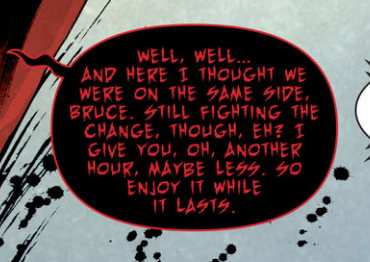
It’s…not easy for me to make out in print comics, and even reading it on my iPad, zoomed in as much as I’m able, was a pain in the rear. I made it through an issue on my pad, and then opted to try reading it through my television instead.
That did the trick…blowing it up nice ‘n’ big on a large flatscreen made the red-on-black balloons a tad easer to discern. But apparently this mini-series realized it was being far too lenient on me, and unleased its secret weapon: RED ON GREY TEXT:
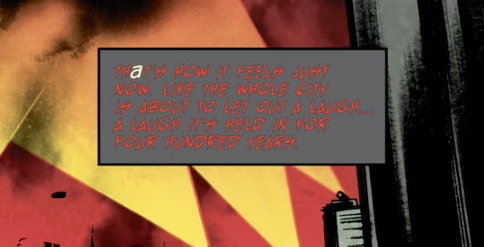
Man, there’s, like, almost no way I could have read this except for being blown up on a flatscreen, and even then it was a struggle. When I was doing screengrabs on my computer for this post, I found I couldn’t make them out, and I have a pretty good-sized monitor for my desktop computotron.
I eventually muddled through the series (I ended up enjoying it, despite everything), but man, I have a real distaste for these novelty-colored captions and word balloons. I think Swamp Thing’s black-on-orange dialogue is about as far as I’m willing to travel, and even that isn’t quite as legible to my peepers as it once was. If comics are going to continue to do that sort of thing, either bold the text more, or use higher contrast colors (the Batman Who Laughs seems to have white-on-black balloons in current appearances, which is a vast improvement).
And in short order DC Universe (when it becomes the digital comics only DC Univesre Infinite) is going strictly to tables/phones/computers, dropping TV support. I’m sure there are workarounds, but it won’t be as convenient as “selecting the app on my Roku” easy, so I may be losing that option for reading other comic lettering in this style.
Okay, okay, that’s enough waving my red-tipped cane at you publishers. I just hope they take things like “readability” into consideration when they do stuff like this.
I do have one more question arising from my Batman Who Laughs reading: what was the Gotham street planning commission meeting like that resulted in putting up an actual damn street sign that reads “Crime Alley?”
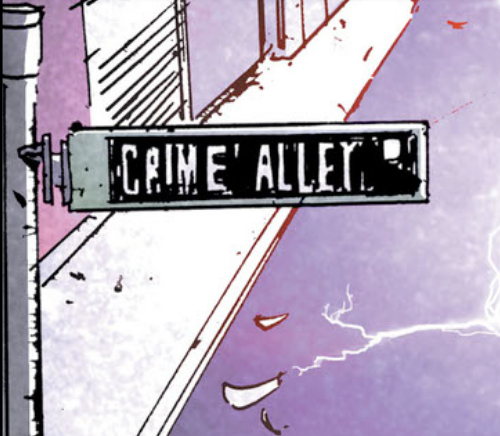
I mean, yeah, sure, it’s Gotham, this is probably the least crazy thing the city’s government has done. However, even assuming there are no businesses or residents on this particular stretch of road, surely anyone located nearby would be all “WHAT ARE YOU DOING TO OUR PROPERTY VALUES?”
I always figured “Crime Alley” was the nickname inhabitants of Gothan had for the road, I never realized it was an officially sanctioned street name. Though I suppose we’re lucky millionaire socialite Bruce Wayne didn’t insist that it be called “My Parents Are Deaaaaaad Way.”
Okay, let me follow up briefly (ha, you know how that usually goes) to some of the responses to my last post. Regarding the idea of getting comics into supermarket checkstands, it was pointed out that’s a lot easier said than done, given that 1) Archie digests were basically grandfathered in (hence that brief deal Marvel had with them to get their digests distributed into your local Piggly Wiggly), and 2) there’s a stupid amount of competition for that immensely valuable space. Marvel and/or DC aren’t exactly going to be able to march right in there. (Y’know, without cutting a deal with Archie again.)
Also noted is that putting comics into anything other than a bookstore environment is likely not going to work out. Department stores are, in general, allotting less space for books and magazines these days, and even if they did, there’s no real care or curation going on there. No guarantee you’ll see your comics on a regular basis (as Brad points out, a new run of Disney comics are pretty tough to find), or even at all (I never did see any of these DC Giants at Walmart).
I suppose it doesn’t really matter so much…as long as they’re there, they’re visible, and kids show an interest, and the sale is made, the job is done. These sources can act as feeders to places like actual bookstores and even a comic shop where there would be ample supply of related material and (hopefully) a knowledgeable employee to help them along. Which is ultimately the goal of this sort of distribution.
Thom H. asked, in response to my assertion that comic shops may not be ready for a switch from a periodical model to a trade based model:
“Is this because there are so many readers of the periodicals still around, and they wouldn’t make the switch? Or comic shops wouldn’t be able to handle the change in format? Or some other reason? I’m genuinely curious because I can’t decide how I feel about the idea.”
I’m probably being a tad bit shortsighted, admittedly. I’ve heard of stores that have made that change, at least partway, focusing more on the book end of the comics market versus that weekly Wednesday (and now a little Tuesday, thanks DC) bump.
But as it stands now, it’s the arrival of the new comic books that drives most customers into stores. Now if suddenly the only way to get stories of your favorite characters is to buy a $14.99-$19.99 trade paperback of new material once every four to six months, then I suppose several people would make the switch. But the frequency of visits would decline, I’d imagine…instead of coming in monthly for Green Lantern comics, now it’s every few months for the new paperback), and yes, prices may go up but without as many people buying as many comics on a frequent basis…well, basically, there’d be a lot of economic adjustment on both the retailer and the customer’s parts to continue this hobby.
Short answer: I don’t know what would happen, but it would involve change and after 32 years in this business, change gives me the stomach-tumblies. But I’d figure a way to make it work, because what else am I going to do at this point? Get a real job?
• • •
Okay, let’s try to tackle a couple more questions before I hit the sack, and let me tell you, that sack has it coming:
Dean puts me on double secret probation with
“Since you e opened your own shop., what’s the oddest/most random request for a back issue you actually had in stock?”
That’s a good question…I don’t think I’ve been hit with any particularly wild requests, though. I think having someone ask “do you have Reagan’s Raiders”
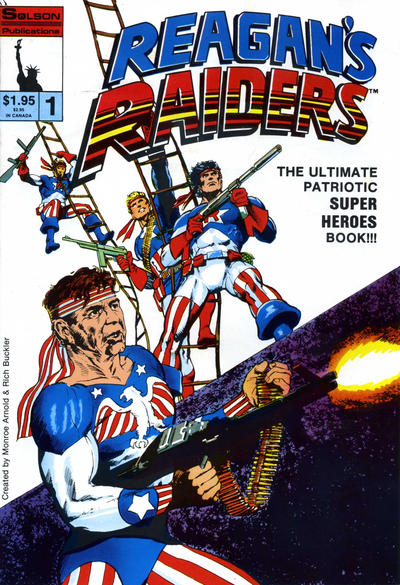
and lo, I had it.
Not to say I’ve not had people amazed that 1) I’ve heard of the comic they’re asking after, and 2) I actually had a copy, but I don’t think it’s been anything especially strange. Had one fella just falling over himself in surprise that I had any copies at all of Too Much Coffee Man, for example, but that’s not really a weird or funny answer, I think. I guess Reagan’s Raiders is the one that comes to mind. Sorry, I’ll try to remember if there was anything else!
• • •
Tim conjures up this question
“Do you, like me, think the Joker is played out as a viable character?”
I think he’s overutilized, especially right now (what with an extended storyline in Batman wrapping up, a prestige series currently in progress, and a couple other oversized Black Label books running or just wrapped up). Plus we had a high profile movie featuring the character not too long ago, back when there were still movies, and other mass media appearances of the Joker tend to cast long shadows. So yes, there’s more than enough Joker to go around of late.
But does that make him less viable? The Joker is Batman’s arch-nemesis, the literal embodiment of the world’s chaos that Batman seeks to bring to order. That, I believe, makes the Joker eternally viable…as long as there’s a Batman, there will be a Joker, to be really on the nose about it. But how can we miss the Joker if he won’t go away, and having Joker always appearing in something on the new comics rack makes his appearances less special, have less of an impact, and that does lessen the viability of the character. Batman: Three Jokers should stand out more than it does as A Special Event, but instead it’s Yet Another Joker Comic.
Maybe it’s nostalgia feeding this feeling of mine. I remember reading one Joker story as a kid where he seemingly dies at the end of the story (a boat he’s on blows up, and Batman’s all “is that the last we’ll see of the Joker?”). I knew full well the Joker wasn’t dead, but I was looking forward to his next appearance where I presumed there’d be an explanation of how he got out of that one. However, when he eventually popped up again, no dice. We just swung back into the next Joker adventure.
Now I bring that up partially to register a complaint from Young Mike about comics continuity, but mostly to point out I had to wait for a follow-up Joker story. It had to have been a few months, at least. It kept me wondering, and anticipating his return. But today, you kids have it easy, what with a Joker in every other comic.
Well, Joker is immensely popular, and he sells comics, so I see why DC wants to use him as often as they do. But maaaaybe spacing out the appearances a bit might make those Joker stories a little more special. I mean, c’mon, when was the last time we had a good Tweedledum and
Tweedledee story? Let’s give them their time in the sun with a multi-parter already.
So in Monday’s post, I linked back to an ancient entry on my site regarding the insertion of flexidiscs into comic books. I warned this particular entry was rife with dead links, but I should probably have noted there was some dead information there as well.
2004 Me stated “we can pretty much forget about seeing comics with flexidisc inserts ever again” given that record players were on the way out. Well, 2020 Me knows that actual vinyl records have made a resurgence…and never really went away in the first place, though it feels like they’re more of a “thing” now. Could be I’m just more aware of it, after inheriting a large-ish collection of LPs from my grandparents and purchasing a brand new record player. And buying new records. And haunting local thrift stores for any album donations. And maybe taking in some Nipsey Russell records at the shop for store credit.
At any rate, Records Ain’t Dead, and neither are flexidiscs being distributed in funnybooks, and I had claimed. Reader Matthew was first in the comments to note
“Post York #1 (published by Uncivilized Books) in 2012 and Hip Hop Family Tree #12 in 2016”
and I do remember taking preordeers on that Hip Hop Family Tree specifically for the inserted flexidisc.
And then BKMunn pointed in the direction of this now sold-out comic from a musician that included a flexidisc.
I guess there’s still some life in the ol’ flexi just yet. Now if we can get paper/cardboard discs on comic book back covers that we’d have to cut out, like we older folks used to do as kids with cereal boxes, that’d be great. There’s a gimmick I coiuld get behind. GET ON IT, um, I don’t know, VAULT COMICS I guess.
• • •
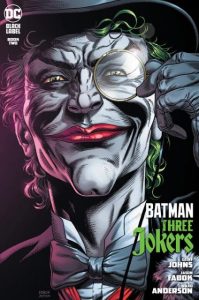
Okay, I didn’t read a lot of new comics this week (been watching
I, Claudius on DVD and streaming the final season of
The Good Place now that it’s
finally made its way to Netflix) but boy howdy did I read
Batman: Three Jokers #2. I won’t go all into it like I did with the
first issue, but suffice to say that the art by Jason Fabok (both interiors and all those covers) is still spot on. The story…
welllll, this is one of those comics that feels like a ten pound load in a fifty pound sack. A lot of this probably could’ve been taken care of in a single 48-page special or, you know, a two-parter at most.
The majority of this issue is concerned with the ramifications of events from the last issue, so there’s lots of interpersonal drama and a set-up for either a big reveal next issue (placing this firmly in out-of-continuity territory) or a big reset button (making it in continuity or whatever passes for it now). I mean, whatever, it’s fine…not as important as it wants to be, and it’s kind of sweet that it’s trying so hard to tie itself to the look ‘n[‘ feel of The Killing Joke. I know some online hay was made out of a shot of a couple of manilla folders, one marked “missing criminals,” and the other marked “missing clowns,” and c’mon, there’s kind of a weird ridiculous beauty to that.
• • •
Still taking comic artform/business/whathaveyou questions to answer here in the coming weeks, so just drop one
into the comments at that post if you can!
[SPOILERS for Batman: Three Jokers ahead]
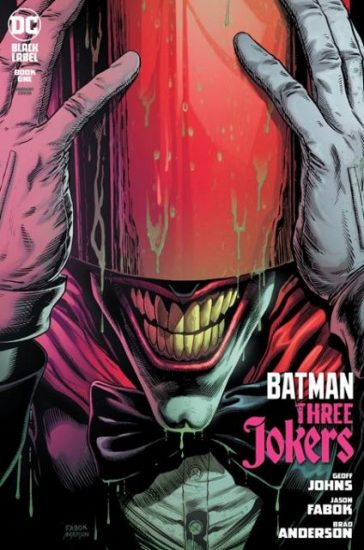
So Monday afternoon, I did something I almost never do at the shop…I read a comic book.
I’ve heard plenty of times over the years “wow, it must be great to work in a comic book store and just read comics all day,” and I think in the 32-years-next-month I’ve been doing this, I’ve maybe read…a half-dozen comics while on the clock? I mean, my lunch breaks don’t count, I would assume, but even then I wasn’t reading comics…I’d maybe poke through Wizard or screw around on the internet.
But this time, after I’d broken down the DC Comics shipment, and did all the comic saver pulls, instead of doing anything useful like pricing that stack of Deadpools I obtained from that defunct store stock, I decided to just straight up read that Batman: Three Jokers comic that’s all the rage at the moment.
And you know…I thought it was fine. Geoff Johns in his particular wheelhouse here, just doing a plain ol’ Batman story despite the weight it’s carrying from the hype and the marketing. Like a good percentage of Johns’s work, it is directly building on a foundation laid by Alan Moore decades prior. However, unlike Doomsday Clock, where the reach for Watchmen exceeded the grasp, here he’s fiddling around with The Killing Joke, a comic that critical history, and Moore himself, have decided is one of the writer’s lesser works. As such Johns here feels a little less out of his depth, addressing not only the consequences of The Killing Joke but the decidedly dumb-but-impactful “Death in the Family.”
In fact, I think that’s one of the clever bits of Three Jokers, in how it entwines both of these events together, and forces the two characters directly affected by these events (Batgirl and the second Robin Jason Todd, now “The Red Hood”) to confront their respective histories with the title character(s) of this story. In fact, Johns somehow managed to make Todd’s past experience even more excruciating and terrifying…and I should clarify, I mean this as a compliment, as I found this probably the most effective scene in the issue.
As to the overall plot…I won’t delve too deeply into spoilers, if at all, but I’m glad this seems to be more of a Batman-milieu rather than a “DC Multiverse” thing. Given the origins of this whole “three Jokers” business to begin with, involving the Justice League and the New Gods and Batman using Metron’s Mobius Chair to find out “wait, how many Jokers?” — well, in the, what, four years since that info dropped I’d been expecting some kind of parallel universe explanation. But that doesn’t seem to be the case here. I mean, who knows, there are two more issues to go, maybe Pariah will show up.
Well, one thing about the conceit of Three Jokers is that it provides an alternate explanation for the many versions of Joker we’ve seen over the years to the one Grant Morrison has been trying to sell us since his Arkham Asylum graphic novel in 1989 (as occasional partner-in-crime Ken Lowery reminded me). The specific example I’d mentioned was the more recent Batman #663 from 2007. In essence, the Joker reinvents himself, undergoes a shift in personality, which is something we witness directly in that Batman comic. It seemed like a perfectly good way to explain the multitudes of Joker’s personalities we’ve had over the decades, and fit very well with the character.
Johns’s premise is not so elegant, presenting instead the idea that there are literally three people running around as the Joker, each with their own style and tone. As I saw someone point out on the Twitters, you’d think this would make Batman look bad, being unable to tell that was what was going on. I don’t want to use the term “idiot plot,” but maybe we can just suppose that Batman had some kind of brainfart and overlooked the fact that the Joker maybe had a slightly different jawline than he remembered, or that his eyes were spaced differently. Or maybe Batman attributed the differences to the affects had by the beatings he’d give him. Who knows.
I should note that the art is great…Jason Fabok really puts in a good show here, especially with the various portraits of the Joker he’s prepared for the many variant covers (as well as a few of the Batfamily). Given the content of the story, the deliberate biting of the panel layouts of The Killing Joke is actually quite fitting. If a Killing Joke sequel has to be made (SPOILER: it probably doesnt) then you can do worse than tying the new work to it visually. Anyway, it’s definitely a gorgeous looking package.
A couple of continuity points, or lack thereof as the case may be:
A line of dialogue notes the Joker’s first appearance “decades ago,” which means at minimum two, if we’re being literal. I presume this is Johns’s way of saying that the five-year-timeline of the New 52 is good ‘n’ gone after the events of Doomsday Clock.
However, when I mentioned that on the Twitters, it was pointed out to me that Three Jokers isn’t mainline DC continuity, so maybe that “decades” comment doesn’t apply to any other DC Universe title outside the series. Given that nobody really has any clue what constitutes continuity or not at DC anymore, I don’t suppose it matters that much. If I recall correctly, even The Killing Joke wasn’t necessarily intended to be in the regular DC continuity…which of course changed once Batgirl debuted as the wheelchair-wielding Oracle in Suicide Squad.
It does seem weird, though, that a mystery set up in that most in-continuity of DC Comics, Justice League, would get answered in an out-of-continuity series. Would that mean the mystery remains unsolved in-universe? Well, I think DC’s “Rebirth” was since then, anyway, so maybe they made that event Never Not Was. Or we could just not worry about continuity and enjoy the story as is…like some kind of crazy person.
Oh, and is there a Swamp Thing connection? Your bet your tubers there is! Say so long and farewell to the late Dr. Roger Huntoon, who first appeared during Rick Veitch’s Swamp Thing run, killed off panel in Three Jokers #1. Here he is in Swamp Thing #79 (1988), bothering Lois Lane:
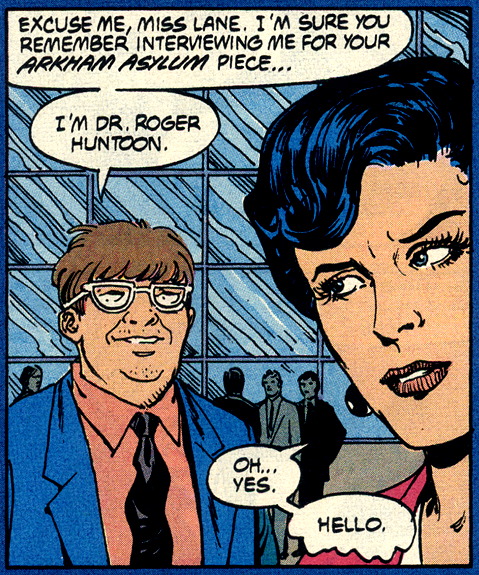
Alas, we hardly knew ye, Dr. Huntoon. We’ll see you again, in the next reboot.
Ultimately, will anything going on in this series stick to the character? Joker seems awfully resistant to any long-term alterations to him or his premise. I think the whole “Red Hood” thing that was retroactively added to his history back in the ’40s, and the shooting of Barbara Gordon and the crowbarring of Jason Todd have both stuck (hence this series). Everything else just seems to slough off…any attempts at giving him a Real Name don’t last (“Jack Napier” seems to have lasted the longest, having returned after a long hiatus in the out-of-continuity “White Knight” series). Three Jokers seems to be foreshadowing a revelation regarding the Joker’s name, but I’m sure that’ll eventually go the same way. (Maybe some Jokers will be named, and others won’t…we’ve got plenty of them to work with here.)
To wrap up this already overly-long post, I think Batman: Three Jokers is fine. Beautiful art, a serviceable script, and a weird game-changing premise that may or may not survive the end of the series. But boy, those covers are nice.
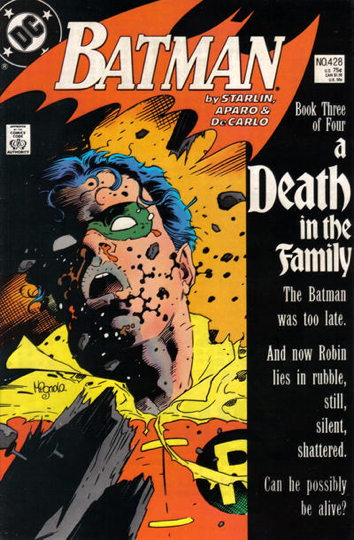
I’ve mentioned before on the site that one of, if not the very first, Big Event What Got Real World News Coverage I had to deal with upon entering the world of comics retail in 1988 was the Death of Robin. Or “A Death in the Family,” which was the actual name of the storyline.
In case you need reminding, that was the series where at the end of the second issue of the story (at least in the direct market versions) readers were asked to actually phone in and decide if Robin lived or died after having the Joker do this to him:

I wish I could remember more specific retailing shenanigans I experienced at the time regarding this event, aside from vague memories of phone calls and walk-ins wanting to know more about Robin’s impending doom, but this was a while ago, and “Mike writing about comic events on computers” was still a few years in my future after discovering BBSes.
But, I was reminded of all this after watching a recent episode of “DC Daily,” which is the weekday news/discussion show on the DC Universe streaming service. The topic of discussion was this very storyline, being discussed in the context of celebrating Robin’s 80th anniversary, and given that the guy on the panel that they usually joke about being the “old man” of the group is a decade and a half younger than I am, I think most, if not all, of the participants here, didn’t experience this story until well after it was published.
Which is fine, doesn’t make me feel old at all, no sir/ma’am/other, but it feels weird to me to have this just be something that was always an established part of the character. Like, it’s some odd bit of history that you have to unearth after the fact, rather than something that you and everyone you know that was into this same sort of thing experienced together as it was happening. “Yes, Mike, tell us more about the passage of time and how new things become old things,” I know, I know, but it’s always a strange experience to listen to people experiencing something (or describing experiencing something) for the first time after the fact, that you yourself lived through first hand.
(As an aside, I’m experiencing the same sensation listening to this very funny podcast where a couple of folks are experiencing the Star Wars movies and associated nonsense for the first time. Sometimes it can be immensely frustrating and I get all worked up over them calling Jawas “droids” or whatever, but that’s more a comment on my own obsession. It’s a good lesson in “not everyone is as overly involved in the same dumb things you are.”)
The one thing the DC Daily panel brought up, that I can’t really remember for sure from the time, is that general fan reaction to this particular Robin, who was the second Robin Jason Todd, was not positive. That for some reason people didn’t really like Jason and that putting him on the chopping block for the public to decide was pretty much proof that he was not liked.
My general recollection was that, in the issues leading up to his death, Jason Todd was being written in a way to make him seem…at least darker, if not less heroic. I think the issue just before the “Death in the Family” storyline had a bad guy fall to his death off panel, and it’s strongly implied (in other words, “straight up taken as read”) that it was Jason who caused his demise. It felt like he was being written in a way that would make readers glad he was gone.
But prior to that, I don’t recall much negative response to the Jason Todd Robin. I wasn’t a regular reader of the Batman titles at the time, so maybe there was some pushback against him in the letter columns, but I don’t have any memory of there being any open disdain for the character in the fan press. He was originally around for only, what, five years? Doesn’t seem like long enough for some kind of hate-campaign to build up around a character that I thought was a mostly indistinguishable replacement for another character in those pre-wide-access-to-the-internet days. Not like the hate that built up around Damian Wayne when he came on as the new Robin years later, before everyone realized he was in fact awesome.
So anyway, that’s what I’ve come to ask you all, if you’re old like me and actually read mid-1980s Batman comics. Did you dislike Jason Todd…I mean, before they were deliberately writing him as a jerk near the end there? Or were they writing him as a jerk prior to that? What was going on there?
[SPOILERS for recent events in Batman comics]
So I think none of us who are devoting any minimal amount of thought to the apparent death of Alfred are thinking “if” over “when” in regards to the character’s eventual return. It goes without saying, but I’m saying it anyway, that a vital part of a franchise like this won’t be out of the picture for very long. Now granted, Alfred isn’t entirely indisposable — the only indisposable part of Batman is “dude what dresses up as a bat” — but he’s certainly an expected part, and certainly noticeable in his absence.
Anyway, I was thinking about Alfred’s death (and the on-panel death seemed to be about as definite as these things get) and how DC would eventually bring him back, which inspired me to slap together this poll for the Twitters:

Before I get into the results, let me talk about the choices I included. “Never actually dead” is pretty self-explanatory…some kind of fake-out or ruse or clone or whathaveyou, leaving him alive but out of the picture somewhere. This is pretty much the deal with the whole “Death of the Human Torch” story.
The second option, “Magic/science shenanigans” covers things like the Lazarus Pit, or Herbert West-style reanimation, or, well, clones, I guess, so there’s bit of a grey zone between this and the first option. I suppose the Death of Superman would fall under this, though if I recall correctly there was maybe a tiny, tiny bit of life in him so maybe he wasn’t entirely dead and now you’re beginning to see the choices aren’t nearly as cut and dried.
Option three is again, probably self-explanatory…if you don’t know what a reboot is, I refer you to the past decade or two of Marvel or DC comics. But if you need a specific example, perhaps the Legion of Super-Heroes rebooting itself out of a painted-in corner during Zero Hour.
What’s interesting about the results is that “Reboot” was the choice that garnered the most votes in a relatively short amount of time. It’s probably the most cynical of the choices, but not unwarranted by the publishing strategies of the Big Two. It speaks to a lack of faith in publishers providing a satisfying resolution to a story, or committing to any significant changes or plot developments. The Reset Key remains a looming threat.
In my mind, the other two options, “never dead” and “shenanigans,” feel more likely. In chatting with Brian Cronin, who noted that the death of Alfred was perhaps a top-down decision at DC, has me thinking that the ultimate goal will of course be the big “RETURN OF ALFRED” to-do in the Bat-books, or across the DC Universe line, with all the attendant tie-ins and such. A wild plot/character development now lays down the groundwork for a big payday later, everyone hopes.
Now I suppose it’s possible this now just the new status quo at DC, along with Batman having a biological son, or Superman and Lois having a son, but even those are only permanent ’til another reboot passes through. …Perhaps a good follow-up poll would be asking “when?”
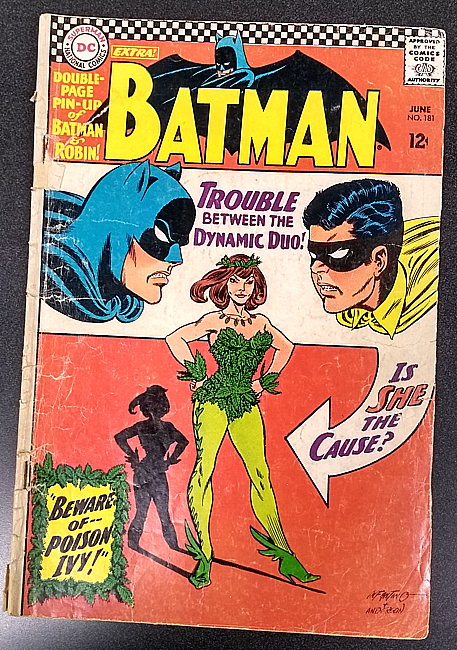
Used to be I’d see these on a pretty regular basis at the former place of employment…copies of Batman #181 from 1966, featuring the first appearance of Poison Ivy, used to stack up on us. They were plentiful, they were not terribly expensive (particularly in the conditions they were usually found), and generally had copies available for anyone who happened by and asked for one.
Which is why I was a tad surprised when, after I received the copy pictured above in a collection, sold it within literally a minute after posting it to the store Instagram account. But then, the time of Batman #181s aplenty that I was reminiscing about above was sometime in the early to mid 1990s. The comic was only about 30 years old then. It’s closer to a fifty year old comic now.
Age, of course, isn’t the sole attribute determining a comic book’s demand and/or value, as anyone who’s had to respond to the assertion “it’s old, it has to be worth something” knows. But age can impact availability…the more time passes, the more older comics like these get absorbed into collections, or outright destroyed. Particularly nowadays, with the new influx of collectors seeking “key” issues, items with significant importance to the hobby (like, say, the first appearance of o villain for a major superhero character) are snapped up in short order, particularly if they’re “raw” (i.e. not already slabbed in those plastic cases with an “official” condition grade) and reasonably priced (as my copy here was, in my humble opinion).
Not to say they’re hard to find, which I realize I have been saying. You probably can’t swing a dead Catwoman around on the eBays without hitting a half-dozen or more of Batman #181s, sealed up in those cases and premium-priced. But the days of finding stacks of them, unslabbed, like at my old job back in ye olden tymes, are, if not gone entirely, at least far less common than they used to be.
That’s a lot of typing just to say “tempus fugit,” but fugit tempus does, and with me entering my 31st year of comics retail this month, I just got to thinking about how things have changed in this business. I mean, not big things, like “there’s only one distributor now” and “remember when comics used to sell” but minor shifts in collecting habits and back issue supply, like I was saying in all that stuff up there.
Okay, first off, right now it looks like everyone’s all “woo-hoo, it’s the 30th anniversary of that first Tim Burton Batman movie starring Prince” and I’ll have you know I’m so ahead of the game, I posted about that film for its 28th anniversary! Take that, Batty-come-latelies! Anyway, I even created a special category for those posts where I talk about my retail memories of that exciting time when the words on everyone’s lips were “Mr. Mom is Batman!?” so be sure to click on that link there and bask in the nostalgia.
Now, one of the problems of doing a comics blog that updates usually about three times a week (or less, depending on which of my eyeballs has exploded this time) is that I don’t tend to concern myself with the day-to-day Hot Comical News that’s all the rage on your Mastodon incidents and no other short-form social media sites. I figure everyone else has got it covered, no one’s coming to my site for anything hot off anybody’s presses, they’re coming here to see me talk about Frank Miller’s The Spirit or Swamp Thing or whatever. I mean, after Journalista folded, I tried once or twice to do big ol’ linkblogs to “hey here’s what’s going on” but quickly learned that was the sort of thing I enjoyed seeing other people do, not, you know, do myself.
But occasionally things come up that I have to say something about, like this relatively old but surprising news that the Seaboard/Atlas Comics of the 1970s, mostly notable for launching big then, um, flaming out, have been optioned for movie/TV deals. And I gotta be honest, my first thought when I heard that was “every single other comic book thing must have been taken” — and please don’t take that the wrong way. I adore those Atlas Comics. I’ve written on and off about collecting them here on the site…and I’m about 80% of the way to having a full collection, so this movie news kinda irks me a bit in that I’m sure the issues I still need will suddenly get cranked up in price.
But back to my point that this seemed like a really strange thing to do. And that’s coming from someone who does like these comics. I’d love to see what they’d do with a Grim Ghost movie, for example, even though the reaction would likely be “that’s just a rip-off of Spawn!” grom the grandparents in the audience old enough to remember the Spawn movie. I mean, I guess some characters might be fun to see in live-action…in discussing this with a customer he mentioned that seeing Morlock 2001 on the big screen would be something else, and by God I can’t disagree. And I think Ironjaw would be kind of amazing as well. So, who knows, I shouldn’t judge too harshly. It’s still pretty surprising…who saw that coming?
Another thing announced a little more recently was the impending return of the Legion of Super-Heroes, and there are a bunch of reports about it on the Googles, but I’ll link to this one because it talks about some tie-in Flight Ring replica merch. I mean, good, I’m all for a new Legion series…they’ve been teasing the Legion, after an extended newsstand absence, in Doomsday Clock, but it’ll be nice to just have a full-on Legion of Super-Heroes title on the stands again.
That said, I don’t know if I’ll be back for it, personally. I hope it does well, I hope it gets a new audience that’ll stick with it and not peter off after a year or two, requiring yet another relaunch. I stuck with the Legion books for a long time, and enjoyed them best I could, but finally gave up after relaunch and reboot and re-whatevers…I didn’t pick up the New 52 titles, and frankly I don’t think I ever finished reading the last couple of issues of the incarnation just prior to that.
The thing that might get me to try it out is 1) the artist, Ryan Sook, seems well-suited to the title, and 2) I have enjoyed the writing of Brian Michael Bendis on the Superman titles, and his take on the Legion may be…”modern” enough, for a loack of a better term, to get the attention of current comic fans, and maybe break the perception that the Legion is a relic of an older time in comics. Well, when you get right down to it, all superheroes are relics of an older time in comics, but anyway.
Like I said, I hope it does well, and I hope it lasts a long, long time, in a marketplace where publishers don’t keep their comics running for a long, long time. One of the things that appealed to me about the Legion was the idea that there was a line you could draw from that first appearance in Adventure Comics #247 in the 1950s to the (then) current pre-first reboot issues. That the “Five Years Later” Legion was the same Legion that had, at one point, had to deal with the Fatal Five or the Super Moby Dick of Space or whathaveyou. That the characters and relationships and such had a continuity to them, a history, that you could see where they’d come from and wonder where they were going. (See also “X-Men.”)
That’s not a feeling that’s going to be replicated in a new series, I realize. Too much water under the bridge, too much resistance to giving readers a new book with a steep learning curve and the idea that “you’ve already missed a lot of what’s happened.” Not saying a new Legion can’t been good, just saying it’s not going to give me that ineffable essence of what I enjoyed about the original Legion, which can’t be helped.
Okay, I typed too much and my eyes need their beauty sleep, but let me just touch upon DC’s recent reorganization of their publishing imprints. We’re down to just plain ol’ DC for their main line, DC Kids for kids what read the DC, and “DC Black Label,” which basically replaces the to-be-shuttered mature-readers, occaionally creator-owned Vertigo label. That makes sense, I suppose…DC’s Black Label books have been a sales success of late, whereas the Vertigo brand doesn’t move books like it used to, just by virtue of having “Vertigo” on the cover. I’m sad to see it go, given Vertigo outlived the other similar imprints from DC and Marvel, like “Helix” and “Icon” and…does “Barkerverse” count as an imprint? Let’s say it does, just to annoy you.
I guess that’s fine, which I’m sure relieves DC to no end. But I kind of wish the Vertigo label would stick around, but if a whole series of Sandman-related titles couldn’t revive it sufficiently for DC’s tastes, I guess that’s that. Gonna be strange seeing the Black Label logo on preacher and whatnot. I do wonder what’s going to happen to the Young Animal imprint…I presume that’s Black Label now, though the “Young Animal” thing actually does get in new readers looking specifically for those. I haven’t read every news story on the topic, so I presume somebody covered this somewhere. Same with “Wonder Comics” Maybe the new imprints will have sub-imprints? EDIT:: Yes apparently so.
Oh, and in other news, the Swamp Thing TV show is still canceled. The jerks.
« Older Entries
Newer Entries »












 Okay, I didn’t read a lot of new comics this week (been watching I, Claudius on DVD and streaming the final season of The Good Place now that it’s finally made its way to Netflix) but boy howdy did I read Batman: Three Jokers #2. I won’t go all into it like I did with the
Okay, I didn’t read a lot of new comics this week (been watching I, Claudius on DVD and streaming the final season of The Good Place now that it’s finally made its way to Netflix) but boy howdy did I read Batman: Three Jokers #2. I won’t go all into it like I did with the 











